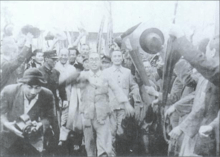Political prisoners in Imperial Japan

Beginning in the Meiji period, the government of the Empire of Japan detained Japanese suspected of political dissidence.[1] Political prisoners in Imperial Japan were released as a result of the fall of the Empire of Japan after World War II, and the policies of the Allied occupation of Japan.
Meiji period – Shōwa period

In 1925, the Peace Preservation Law was passed. Article 1 of the law stipulates that:
"Anyone who organises an association with the objective of change the kokutai or denying the private property system, or who joins such an association with full knowledge of its objectives, shall be liable to imprisonment with or without hard labour for a term not exceeding ten years."[2]
Only about 5,000 out of more than 740,00 suspected violators of the Peace Preservation Law between 1928 and 1941 were prosecuted.[3]
Those who recanted were either released or received short prison terms.[4]
On 4 October 1945, the GHQ issued the Removal of Restrictions on Political, Civil, and Religious Liberties directive, which stipulated the release of political prisoners.[5] It was estimated that 3,000[6] to 2,500 political prisoners were in prison by the end of the war.[7] Following the release of political prisoners on 10 October 1945, the GHQ enacted the "Restoration of Electoral Rights to Released Political Prisoners."[8]
Notable political prisoners
Notable prisons
Memoirs
- Eighteen Years in Prison (Gokuchu juhachi-nen) by Kyuichi Tokuda and Yoshio Shiga. Published by the Japanese Communist Party in 1948.
See also
References
- ↑ Elise K. Tipton (1990). The Japanese Police State: Tokko in Interwar. University of Hawaii Press.
- ↑ Elise K. Tipton (1990). The Japanese Police State: Tokko in Interwar. University of Hawaii Press. p. 62.
- ↑ Elise K. Tipton (1990). The Japanese Police State: Tokko in Interwar. University of Hawaii Press. pp. 28–33.
- ↑ Ben Ami Shillony (1981). Politics and culture in wartime Japan. Oxford University Press. p. 13.
- ↑ "5-3 The Occupation and the Beginning of Reform – Modern Japan in archives". National Diet Library. Retrieved 19 December 2014.
- ↑ "Glossary – Birth of the Constitution of Japan". National Diet Library. Retrieved 19 December 2014.
- ↑ Ben-Ami Shillony (1991). Politics and Culture in Wartime Japan. Oxford University Press. p. 13.
- ↑ Takemae, Eiji (2003). Allied Occupation of Japan. A&C Black.
Further reading
- Milorad M. Drachkovitchy (1986). Biographical Dictionary of the Comintern. Hoover Press. ISBN 9780817984038.
- Mark Gayn (Dec 15, 1989). Japan Diary. Tuttle Publishing. pp. 8–13.
- Takemae, Eiji (2003). Allied Occupation of Japan. A&C Black.
- Henry Oinas-Kukkonen (Mar 30, 2003). Tolerance, Suspicion, and Hostility: Changing U.S. Attitudes toward the Japanese Communist Movement, 1944-1947: Changing U.S. Attitudes toward the Japanese Communist Movement, 1944-1947. ABC-CLIO.
- J. Victor Koschmann (Dec 1, 1996). Revolution and Subjectivity in Postwar Japan. University of Chicago Press.
- Ben-Ami Shillony (1991). Politics and Culture in Wartime Japan. Oxford University Press. p. 13.
- Richard H. Mitchell (1992). Janus-Faced Justice: Political Criminals in Imperial Japan. University of Hawaii Press. p. 154.
External links
- Fuchu Prison Exterior Shiga Yoshio previous release 球一 Tokuda 球一 addressed Tokuda (in Japanese). Wazee Digital Commerce. 10 October 1945.
- Fuchu Prison inmate Kyuichi Tokuda expresses joy at his release while former inmate Tosaji Obara, finance director of the Japan Holiness Church, says his religious beliefs were suppressed while he was incarcerated. (in Japanese). NHK. 7 November 1945.
- "Japanese Diet Called Farce". The Tuscaloosa News. 5 October 1945.
- "Japs to Free 3000 Political Prisoners New Premier Set To Pick Cabinet". The Pittsburgh Press. 7 October 1945.
- "Four Jap Prisons Open Their Doors". Lawrence Journal-World. 10 October 1945.
- "EMACIATED INTELLECTUALS LEAVE PRISON CAMPS". The Age. 10 October 1945.
- "JAPAN TO URGE TRADE OF SILK FOR VITAL FOOD To Ask Permission for Barter System; Communists Would Get Rid of Mikadoism". The Montreal Gazette. Oct 4, 1945.
- "PRISONERS WERE MISTREaTED BY JAPS EVEN IN 1929". Queensland Times. Oct 5, 1945.
- "TOKYO COMMUNISTS, KOREANS SHOUT OPPOSITION TO HIROHITO". Spokane Daily Chronicle. 10 October 1945.
- "CONTROL OF JAPAN Political Prisoners ENFORCING ORDER FOR RELEASE". Kalgoorlie Miner. 17 October 1945.
- "Oust Mikado, Jap Reds' Tip Want Communist Nation". The Milwaukee Journal. Oct 4, 1945.
- "COMMUNISTS SAY BLOOD WILL FLOW IN JAPAN". The Evening Advocate. Oct 4, 1945.
- "Trial of War Criminals To Start Soon in Japan". St. Petersburg Times. Oct 3, 1945.
- "Nippon Communists March Through Allied-Ruled Tokyo, Ask Removal of Jap Emperor". The Bulletin. Oct 10, 1945.
- "Fetters Taken From the Japs by MacArthur". The Milwaukee Journal. 6 October 1945.
- "CAN"T HAVE DEMOCRACY AND HIROHITO, JAPS SAY". Toronto Daily Star. 4 October 1945.
- "American Experience . MacArthur". PBS.